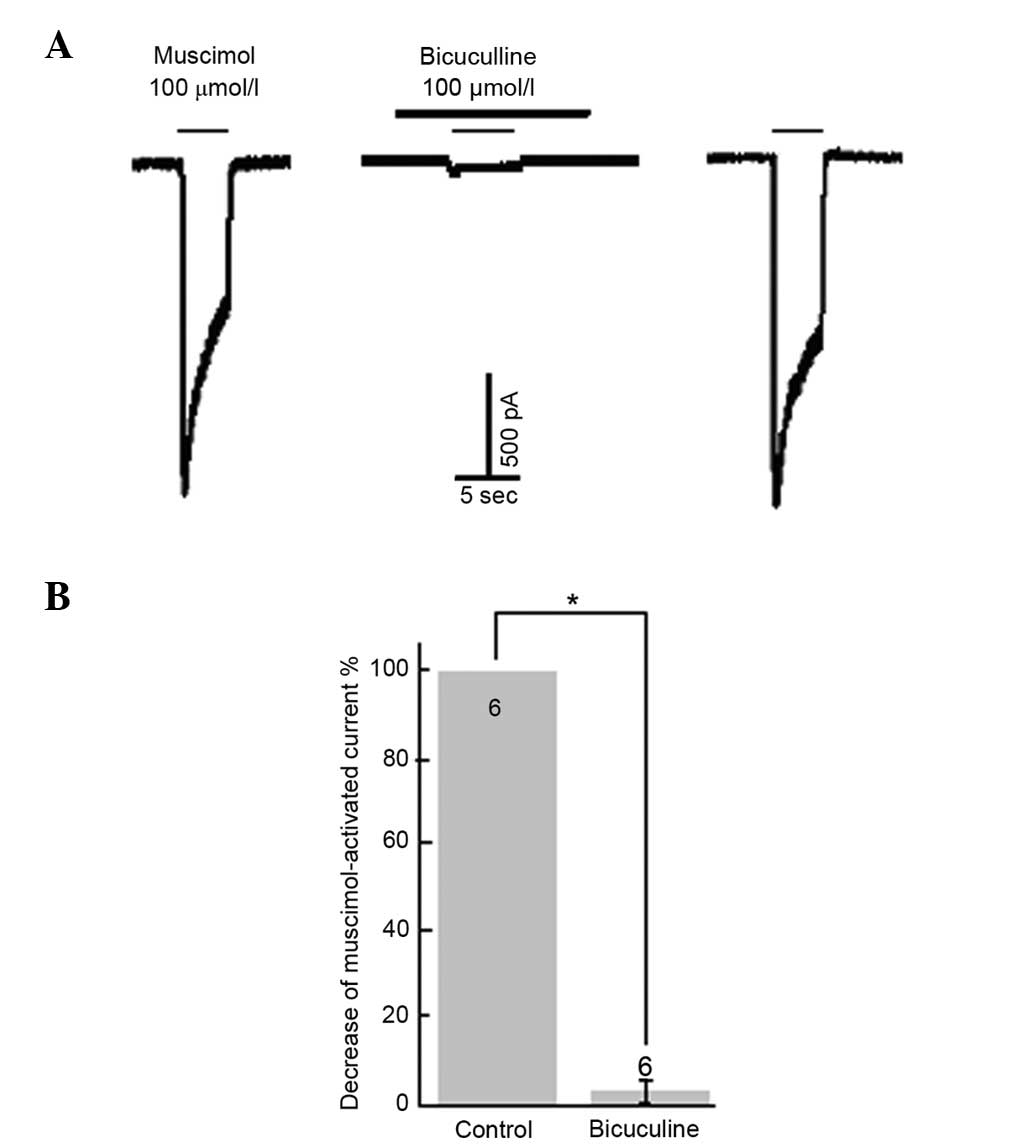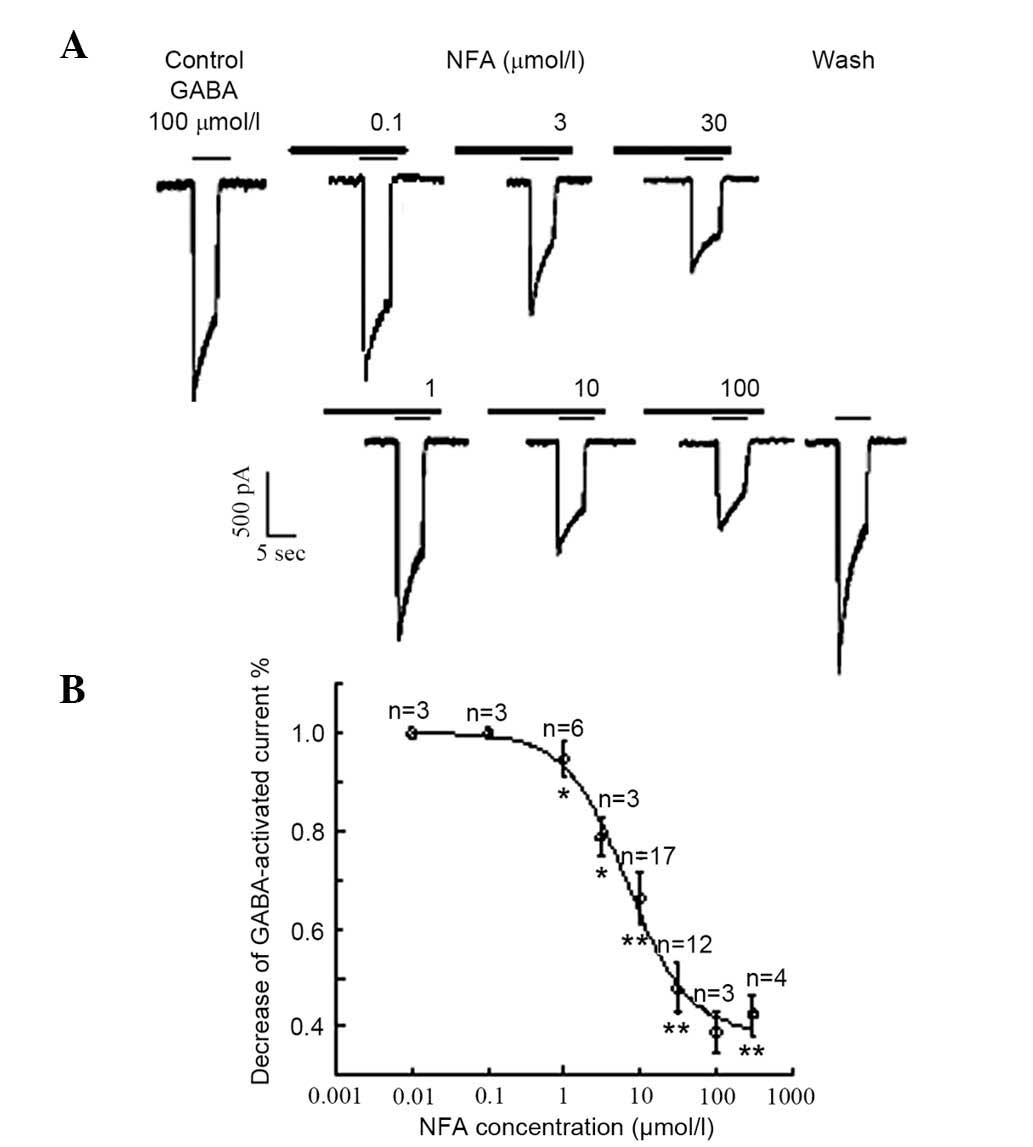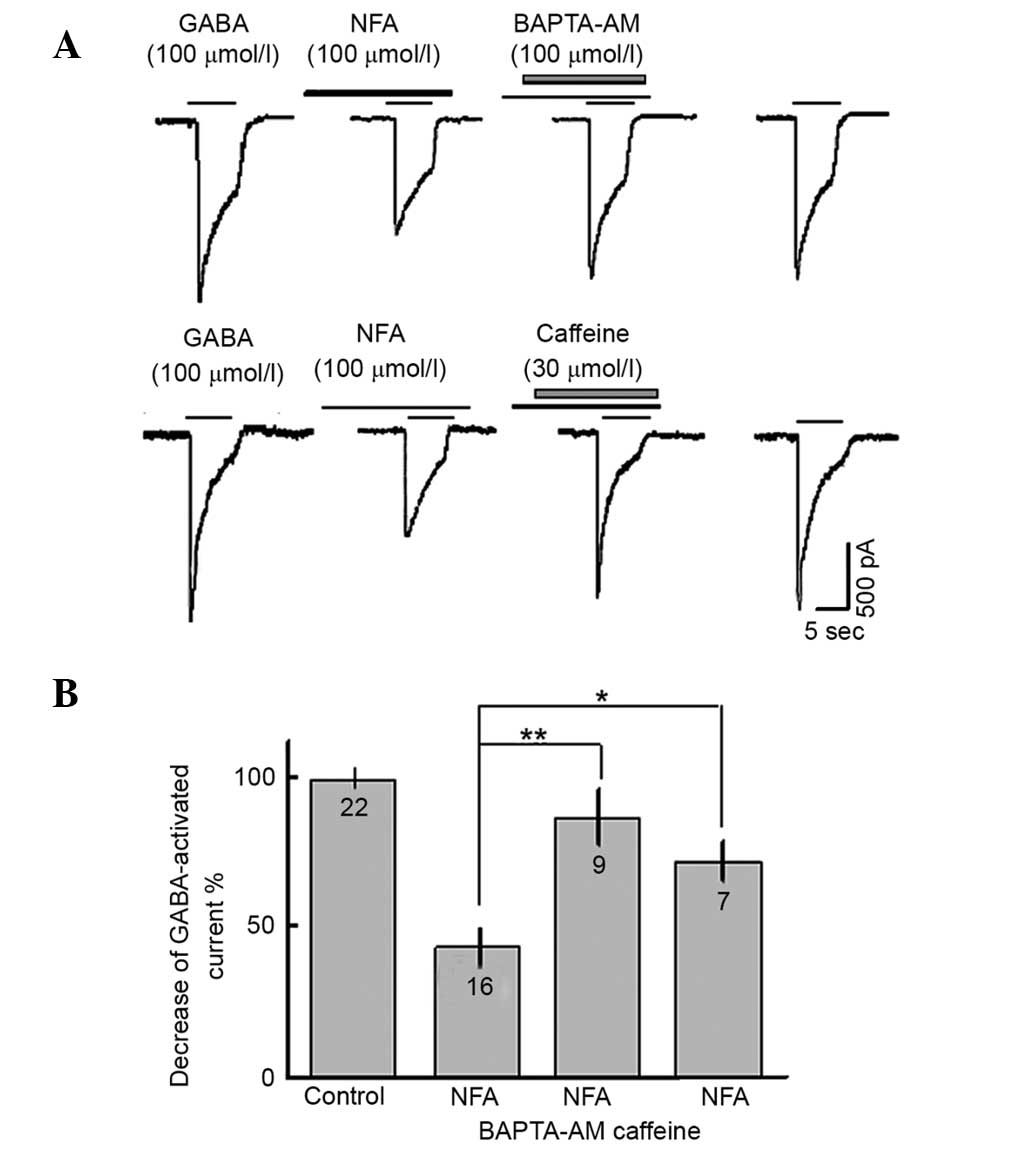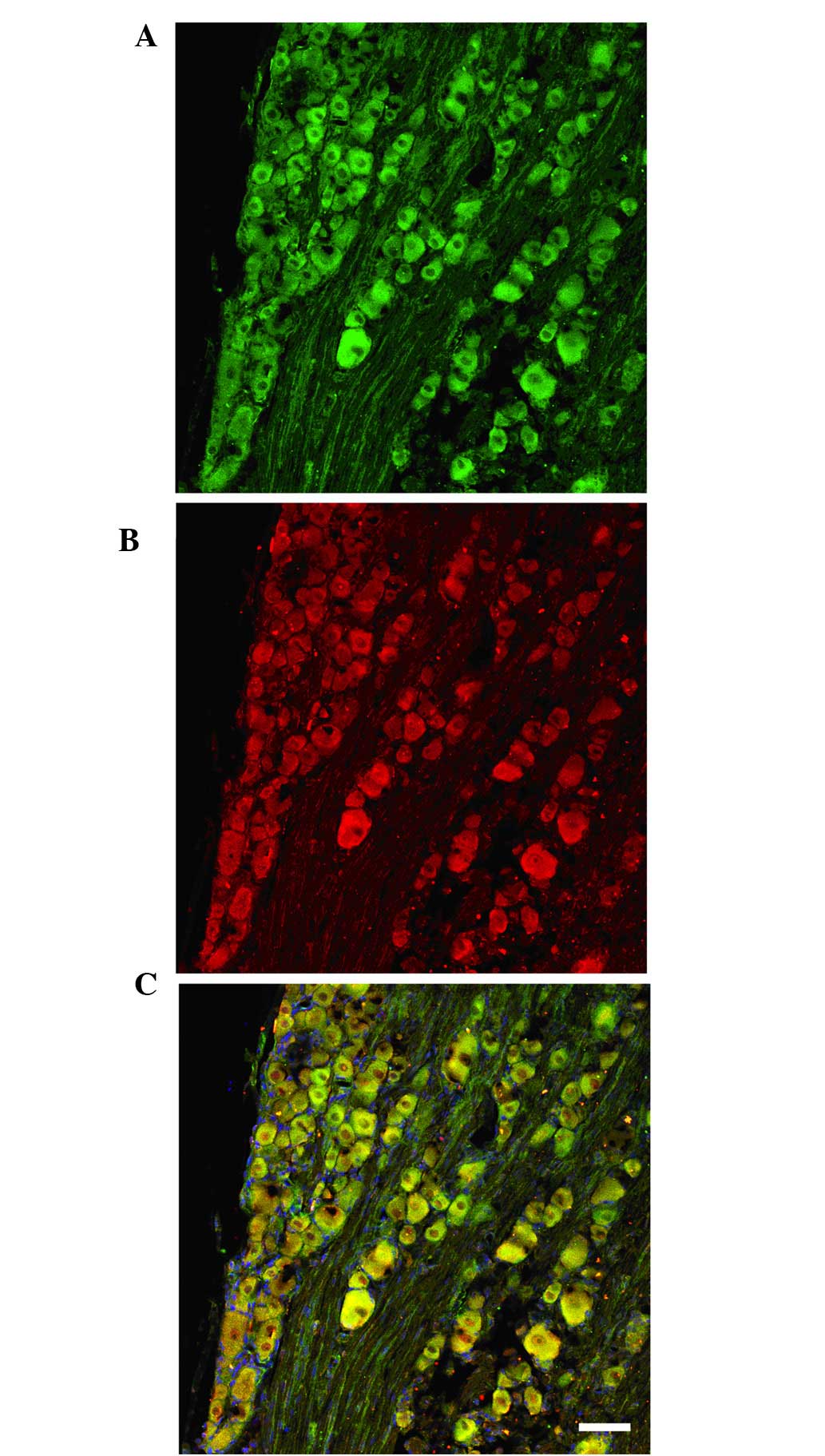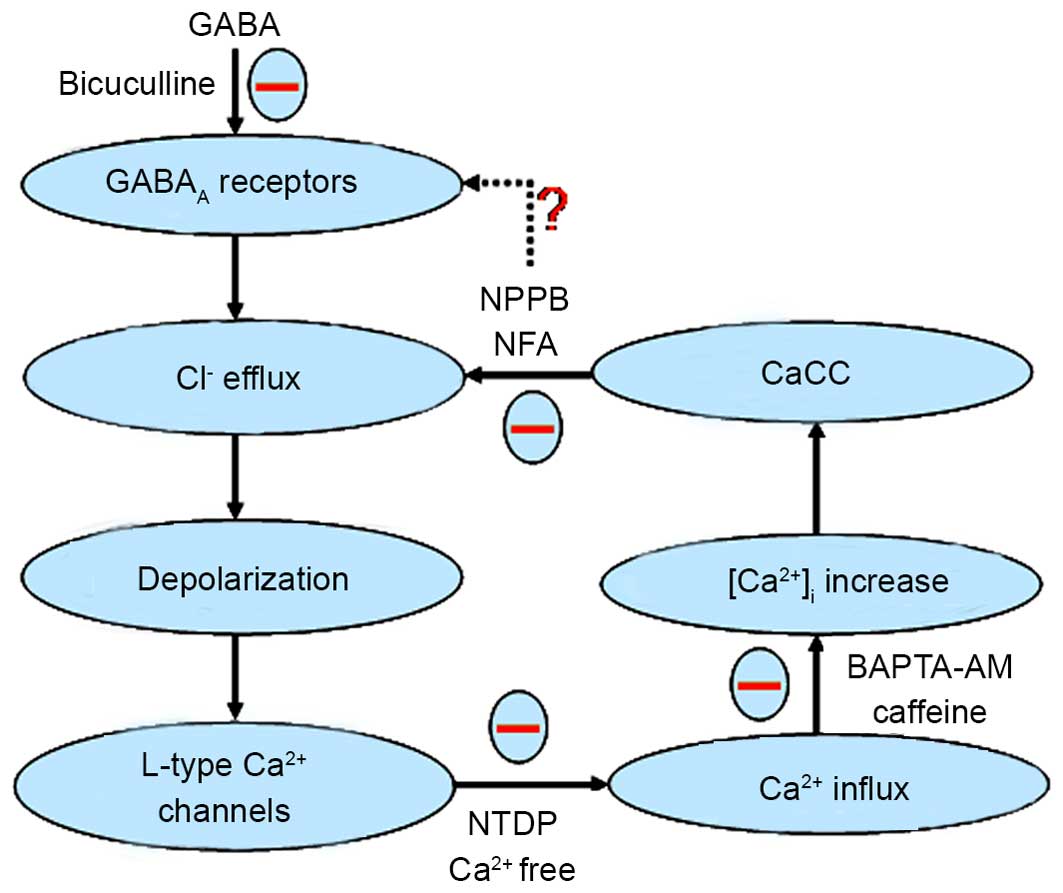|
1
|
Whiting PJ, Bonnert TP, McKernan RM,
Farrar S, Le Bourdellès B, Heavens RP, Smith DW, Hewson L, Rigby
MR, Sirinathsinghji DJ, et al: Molecular and functional diversity
of the expanding GABA-A receptor gene family. Ann N Y Acad Sci.
868:645–653. 1999. View Article : Google Scholar : PubMed/NCBI
|
|
2
|
Mehta AK and Ticku MK: An update on GABAA
receptors. Brain Res Brain Res Rev. 29:196–217. 1999. View Article : Google Scholar : PubMed/NCBI
|
|
3
|
Smith AJ, Oxley B, Malpas S, Pillai GV and
Simpson PB: Compounds exhibiting selective efficacy for different
beta subunits of human recombinant gamma-aminobutyric acid A
receptors. J Pharmacol Exp Ther. 311:601–609. 2004. View Article : Google Scholar : PubMed/NCBI
|
|
4
|
Jensen ML, Timmermann DB, Johansen TH,
Schousboe A, Varming T and Ahring PK: The beta subunit determines
the ion selectivity of the GABAA receptor. J Biol Chem.
277:41438–41447. 2002. View Article : Google Scholar : PubMed/NCBI
|
|
5
|
Babot Z, Cristòfol R and Suñol C:
Excitotoxic death induced by released glutamate in depolarized
primary cultures of mouse cerebellar granule cells is dependent on
GABAA receptors and niflumic acid-sensitive chloride channels. Eur
J Neurosci. 21:103–112. 2005. View Article : Google Scholar : PubMed/NCBI
|
|
6
|
Wallenstein MC: Attenuation of
epileptogenesis by nonsteroidal anti-inflammatory drugs in the rat.
Neuropharmacology. 30:657–663. 1991. View Article : Google Scholar : PubMed/NCBI
|
|
7
|
McKernan RM and Whiting PJ: Which
GABAA-receptor subtypes really occur in the brain? Trends Neurosci.
19:139–143. 1996. View Article : Google Scholar : PubMed/NCBI
|
|
8
|
Greenwood IA and Large WA: Comparison of
the effects of fenamates on Ca-activated chloride and potassium
currents in rabbit portal vein smooth muscle cells. Br J Pharmacol.
116:2939–2948. 1995. View Article : Google Scholar : PubMed/NCBI
|
|
9
|
Malykhina AP, Shoeb F and Akbarali HI:
Fenamate-induced enhancement of heterologously expressed HERG
currents in Xenopus oocytes. Eur J Pharmacol. 452:269–277.
2002. View Article : Google Scholar : PubMed/NCBI
|
|
10
|
Korpi ER, Gründer G and Lüddens H: Drug
interactions at GABA (A) receptors. Prog Neurobiol. 67:113–159.
2002. View Article : Google Scholar : PubMed/NCBI
|
|
11
|
Halliwell RF, Thomas P, Patten D, James
CH, Martinez-Torres A, Miledi R and Smart TG: Subunit-selective
modulation of GABAA receptors by the non-steroidal
anti-inflammatory agent, mefenamic acid. Eur J Neurosci.
11:2897–2905. 1999. View Article : Google Scholar : PubMed/NCBI
|
|
12
|
Sinkkonen ST, Mansikkamäki S, Möykkynen T,
Lüddens H, Uusi-Oukari M and Korpi ER: Receptor subtype-dependent
positive and negative modulation of GABA (A) receptor function by
niflumic acid, a nonsteroidal anti-inflammatory drug. Mol
Pharmacol. 64:753–763. 2003. View Article : Google Scholar : PubMed/NCBI
|
|
13
|
Whittemore ER, Yang W, Drewe JA and
Woodward RM: Pharmacology of the human gamma-aminobutyric acid A
receptor alpha 4 subunit expressed in Xenopus laevis
oocytes. Mol Pharmacol. 50:1364–1375. 1996.PubMed/NCBI
|
|
14
|
Thompson SA, Whiting PJ and Wafford KA:
Barbiturate interactions at the human GABAA receptor: Dependence on
receptor subunit combination. Br J Pharmacol. 117:521–527. 1996.
View Article : Google Scholar : PubMed/NCBI
|
|
15
|
Belelli D, Lambert JJ, Peters JA, Wafford
K and Whiting PJ: The interaction of the general anesthetic
etomidate with the gamma-aminobutyric acid type A receptor is
influenced by a single amino acid. Proc Natl Acad Sci USA.
94:11031–11036. 1997. View Article : Google Scholar : PubMed/NCBI
|
|
16
|
Institute of Laboratory Animal Resources
(US). Committee on Care, Use of Laboratory Animals, and National
Institutes of Health (US). Division of Research Resources: Guide
for the care and use of laboratory animals (8th). National
Academies Press. (Washington, DC). 2011.
|
|
17
|
Si JQ, Zhang ZQ, Li CX, Wang LF, Yang YL
and Li ZW: Modulatory effect of substance P on GABA-activated
currents from rat dorsal root ganglion. Acta Pharmacol Sin.
25:623–629. 2004.PubMed/NCBI
|
|
18
|
Cheng HJ, Ma KT, Li L, Zhao L, Wang Y and
Si JQ: Differential expression of alpha-adrenoceptor subtypes in
rat dorsal root ganglion after chronic constriction injury. Hua
Zhong Ke Ji Da Xue Xue Bao. 34:322–329. 2014.(In Chinese).
|
|
19
|
Ma KT, Si JQ, Zhang ZQ, Zhao L, Fan P, Jin
JL, Li XZ and Zhu L: Modulatory effect of CCK-8S on GABA-induced
depolarization from rat dorsal root ganglion. Brain Res.
1121:66–75. 2006. View Article : Google Scholar : PubMed/NCBI
|
|
20
|
Bernheim L, Bader CR, Bertrand D and
Schlichter R: Transient expression of a Ca2+-activated
Cl− current during development of quail sensory neurons.
Dev Biol. 136:129–39. 1989. View Article : Google Scholar : PubMed/NCBI
|
|
21
|
André S, Boukhaddaoui H, Campo B,
Al-Jumaily M, Mayeux V, Greuet D, Valmier J and Scamps F:
Axotomy-induced expression of calcium-activated chloride current in
subpopulations of mouse dorsal root ganglion neurons. J
Neurophysiol. 90:3764–3773. 2003. View Article : Google Scholar : PubMed/NCBI
|
|
22
|
De Castro F, Geijo-Barrientos E and
Gallego R: Calcium-activated chloride current in normal mouse
sympathetic ganglion cells. J Physiol. 498:397–408. 1997.
View Article : Google Scholar : PubMed/NCBI
|
|
23
|
Mayer ML: A calcium-activated chloride
current generates the after-depolarization of rat sensory neurones
in culture. J Physiol. 364:217–239. 1985. View Article : Google Scholar : PubMed/NCBI
|
|
24
|
Sánchez-Vives MV and Gallego R:
Calcium-dependent chloride current induced by axotomy in rat
sympathetic neurons. J Physiol. 475:391–400. 1994. View Article : Google Scholar : PubMed/NCBI
|
|
25
|
Lancaster E, Oh EJ, Gover T and Weinreich
D: Calcium and calcium-activated currents in vagotomized rat
primary vagal afferent neurons. J Physiol. 540:543–556. 2002.
View Article : Google Scholar : PubMed/NCBI
|
|
26
|
Abdel-Ghany M, Cheng HC, Elble RC and
Pauli BU: Focal adhesion kinase activated by beta (4) integrin
ligation to mCLCA1 mediates early metastatic growth. J Biol Chem.
277:34391–34400. 2002. View Article : Google Scholar : PubMed/NCBI
|
|
27
|
Elble RC and Pauli BU: Tumor suppression
by a proapoptotic calcium-activated chloride channel in mammary
epithelium. J Biol Chem. 276:40510–40517. 2001. View Article : Google Scholar : PubMed/NCBI
|
|
28
|
Yang YD, Cho H, Koo JY, Tak MH, Cho Y,
Shim WS, Park SP, Lee J, Lee B, Kim BM, et al: TMEM16A confers
receptor-activated calcium-dependent chloride conductance. Nature.
455:1210–1215. 2008. View Article : Google Scholar : PubMed/NCBI
|
|
29
|
Caputo A, Caci E, Ferrera L, Pedemonte N,
Barsanti C, Sondo E, Pfeffer U, Ravazzolo R, Zegarra-Moran O and
Galietta LJ: TMEM16A, a membrane protein associated with
calcium-dependent chloride channel activity. Science. 322:590–594.
2008. View Article : Google Scholar : PubMed/NCBI
|
|
30
|
Schroeder BC, Cheng T, Jan YN and Jan LY:
Expression cloning of TMEM16A as a calcium-activated chloride
channel subunit. Cell. 134:1019–1029. 2008. View Article : Google Scholar : PubMed/NCBI
|
|
31
|
Scott RH, Sutton KG, Griffin A, Stapleton
SR and Currie KP: Aspects of calcium-activated chloride currents: A
neuronal perspective. Pharmacol Ther. 66:535–565. 1995. View Article : Google Scholar : PubMed/NCBI
|
|
32
|
Frings S, Reuter D and Kleene SJ: Neuronal
Ca2+-activated Cl-channels-homing in on an elusive
channel species. Prog Neurobiol. 60:247–289. 2000. View Article : Google Scholar : PubMed/NCBI
|
|
33
|
Cruickshank SF, Baxter LM and Drummond RM:
The Cl(−) channel blocker niflumic acid releases Ca(2+) from an
intracellular store in rat pulmonary artery smooth muscle cells. Br
J Pharmacol. 140:1442–1450. 2003. View Article : Google Scholar : PubMed/NCBI
|
|
34
|
Li L, Ma KT, Zhao L and Si JQ: Niflumic
acid hyperpolarizes the smooth muscle cells by opening BK(Ca)
channels through ryanodine-sensitive Ca(2+) release in spiral
modiolar artery. Sheng Li Xue Bao. 60:743–750. 2008.PubMed/NCBI
|
|
35
|
Li L, Ma KT, Zhao L, Si JQ, Zhang ZS, Zhu
H and Li J: Niflumic acid hyperpolarizes smooth muscle cells via
calcium-activated potassium channel in spiral modiolar artery of
guinea pigs. Acta Pharmacol Sin. 29:789–799. 2008. View Article : Google Scholar : PubMed/NCBI
|
|
36
|
Levitan IB: Signaling protein complexes
associated with neuronal ion channels. Nat Neurosci. 9:305–310.
2006. View
Article : Google Scholar : PubMed/NCBI
|
|
37
|
Lerma J and del Rio Martin R: Chloride
transport blockers prevent N-methyl-D-aspartate receptor-channel
complex activation. Mol Pharmacol. 41:217–222. 1992.PubMed/NCBI
|
|
38
|
Coyne L, Su J, Patten D and Halliwell RF:
Characterization of the interaction between fenamates and
hippocampal neuron GABA(A) receptors. Neurochem Int. 51:440–446.
2007. View Article : Google Scholar : PubMed/NCBI
|
|
39
|
Raiteri L, Schmid G, Prestipino S, Raiteri
M and Bonanno G: Activation of alpha 6 GABAA receptors on
depolarized cerebellar parallel fibers elicits glutamate release
through anion channels. Neuropharmacology. 41:943–951. 2001.
View Article : Google Scholar : PubMed/NCBI
|
|
40
|
Van Damme P, Callewaert G, Eggermont J,
Robberecht W and Van Den Bosch L: Chloride influx aggravates
Ca2+-dependent AMPA receptor-mediated motoneuron death.
J Neurosci. 23:4942–4950. 2003.PubMed/NCBI
|
|
41
|
White MM and Aylwin M: Niflumic and
flufenamic acids are potent reversible blockers of Ca2
(+)-activated Cl-channels in Xenopus oocytes. Mol Pharmacol.
37:720–724. 1990.PubMed/NCBI
|
|
42
|
Korn SJ, Bolden A and Horn R: Control of
action potentials and Ca2+ influx by the Ca
(2+)-dependent chloride current in mouse pituitary cells. J
Physiol. 439:423–437. 1991. View Article : Google Scholar : PubMed/NCBI
|
|
43
|
Woodward RM, Polenzani L and Miledi R:
Effects of fenamates and other nonsteroidal anti-inflammatory drugs
on rat brain GABAA receptors expressed in Xenopus oocytes. J
Pharmacol Exp Ther. 268:806–817. 1994.PubMed/NCBI
|
|
44
|
Sigel E, Baur R, Malherbe P and Möhler H:
The rat beta 1-subunit of the GABAA receptor forms a
picrotoxin-sensitive anion channel open in the absence of GABA.
FEBS Lett. 257:377–379. 1989. View Article : Google Scholar : PubMed/NCBI
|
|
45
|
Espinosa F, de la Vega-Beltrán JL,
López-González I, Delgado R, Labarca P and Darszon A: Mouse sperm
patch-clamp recordings reveal single Cl-channels sensitive to
niflumic acid, a blocker of the sperm acrosome reaction. FEBS Lett.
426:47–51. 1998. View Article : Google Scholar : PubMed/NCBI
|
|
46
|
Korpi ER, Kuner T, Seeburg PH and Lüddens
H: Selective antagonist for the cerebellar granule cell-specific
gamma-aminobutyric acid type A receptor. Mol Pharmacol. 47:283–289.
1995.PubMed/NCBI
|















